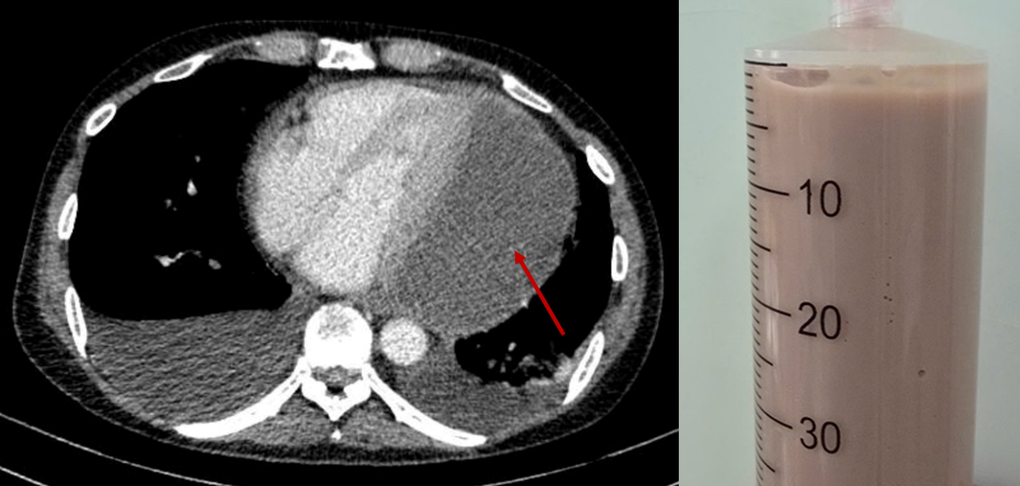On June 4, information from People's Hospital 115 (HCMC) said that this unit had just successfully treated a case of large pericardial effusion. This is a rare disease, causing many difficulties in diagnosis and treatment, especially it can be life-threatening if not detected and treated promptly.
According to Dr. Duong Van Muoi Mot, Head of the Department of Cardiothoracic and Vascular Surgery, People's Hospital 115, 2 months before being admitted to the hospital, the patient began to show signs of chest pain, fatigue and increasing shortness of breath.
The patient had chest pain and difficulty breathing about 2 months before being hospitalized. He went to the doctor but could not find the cause (Illustration: iStock).
The patient had been to many places for examination but the exact disease was not detected and treatment did not improve. The patient had a history of long-term alcoholism, and was recently diagnosed with cirrhosis and diabetes, so his health was increasingly deteriorating.
Upon admission to the hospital, the patient was in a state of general exhaustion, had to breathe high doses of oxygen, had low blood pressure and a very rapid pulse, and was edematous all over the body.
Through ultrasound, doctors discovered a large mass of fluid nearly 11cm surrounding the heart. This is the reason why the heart is squeezed, has difficulty contracting and threatens the patient's life every second.
Immediately, experts from many specialties decided that the patient needed emergency intervention to aspirate the pus from the pericardium. This was considered a difficult aspiration and potentially risky procedure because the pus was located in a difficult-to-reach location and the fluid was thick.
After the intervention, the doctors successfully aspirated 500ml of thick pus, quickly reducing the pressure on the heart. Test results showed that this was a case of severe purulent pericarditis, not caused by tuberculosis or parasites.
Purulent fluid compressing the heart (red arrow) and thick purulent fluid drained through pericardiocentesis (Photo: Hospital).
The patient continued to undergo pericardial window surgery to continue draining all remaining pus, while receiving active treatment with strong antibiotics, strict treatment of underlying diseases, and physical support...
Thanks to timely and active intervention, after only 2 weeks of treatment, the patient recovered spectacularly, no more chest pain or shortness of breath, ate well, and moved normally. The echocardiogram results showed that the fluid around the heart had disappeared. Underlying diseases such as cirrhosis and diabetes were also stably controlled, and the patient was discharged from the hospital.
According to Dr. Muoi Mot, pericardial effusion is a serious infection, but is now quite rare due to the widespread use of antibiotics worldwide (the reported rate worldwide is 1/18,000 people).
In Vietnam, cases of pericardial effusion in adults are also very rare and there have not been many reports of similar cases.
The condition is characterized by a buildup of pus in the pericardial cavity (the membrane surrounding the heart). If not diagnosed and treated promptly, the condition can be life-threatening.
Accumulated pus can spread into the bloodstream, causing severe systemic infection, compressing the heart, obstructing blood circulation, leading to low blood pressure, shock, and even sudden cardiac arrest, leading to death. People with weakened immune systems, chronic diseases, or alcoholism are at higher risk.
Doctor Muoi Mot also noted that the symptoms of pericardial effusion are often not obvious, such as chest pain, fatigue, and mild shortness of breath, so they are easily overlooked. Therefore, when the body shows prolonged abnormal symptoms, people should go for a medical examination to have an early treatment plan to limit future complications.
Source: https://dantri.com.vn/suc-khoe/trieu-chung-de-nham-lan-bao-hieu-can-benh-hiem-cuc-nguy-hiem-20250604163309739.htm

























































































![[OCOP REVIEW] Tu Duyen Syrup - The essence of herbs from the mountains and forests of Nhu Thanh](https://vphoto.vietnam.vn/thumb/402x226/vietnam/resource/IMAGE/2025/6/5/58ca32fce4ec44039e444fbfae7e75ec)







Comment (0)